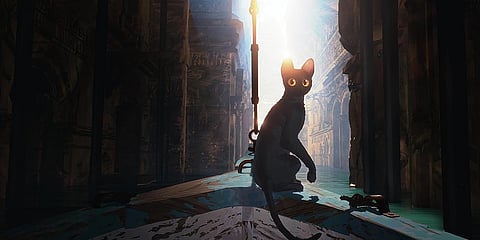Flow: The Oscar-winning animated masterpiece captures the climate crisis with heart
Climate change is an increasingly urgent theme in cinema, yet few films capture its impact as poignantly as Flow. This breathtaking animated feature, which won the Oscar for Best Animated Feature at the 97th Academy Awards this week, is a rare gem that combines visual splendour with profound storytelling.
The film triumphed over animation powerhouses like Pixar, DreamWorks and Aardman. Winning Latvia’s first Oscar, it has also solidified its place in cinematic history.
At its core, Flow tells the story of a solitary black cat struggling to survive in a post-apocalyptic world. Without a human presence, the film follows the feline protagonist on a perilous journey of survival against ever-rising waters that consume everything, encountering an eclectic ensemble of displaced animals, including a capybara, a secretarybird, a ring-tailed lemur and a Labrador retriever.
In many ways, the film plays out like a modern, animal-centric version of Noah’s Ark, where a diverse group of creatures rely on cooperation and instinct to survive. However, there is no guiding figure like Noah here — just the animals, left to fend for themselves in a drowning world.
What sets the film apart is its complete absence of dialogue, allowing the story to unfold purely through expressive animation and sound design. Its deeply emotive writing presents a refreshing departure from success formulas.
Watching Flow, I found myself utterly immersed in this drowned world, feeling every struggle the cat endured; its odyssey is both physical and symbolic. After navigating its safe haven — an abandoned cabin surrounded by large carved statues of cats — the feline is forced to leave its relative safety and embark on a journey that tests its very nature when a flood strikes.
As the cat adapts to the treacherous waters, it is forced to learn new survival skills — swimming, fishing and, more profoundly, coexisting with others. What begins as a solitary existence gradually transforms into one of cooperation and connection. The cat, initially fearful and solitary, embarks on a journey of emotional growth and acceptance, learning to trust, befriend and care for its newfound companions.
Despite the absence of human characters, their imprint on the world remains. The remnants of grand statues, submerged monuments and abandoned cities serve as haunting reminders of a lost civilisation. The film’s environmental themes are both subtle and powerful, drawing attention to the consequences of climate change without resorting to overt messaging.
While many films have tackled climate catastrophe, Flow does so with an emotional intensity that lingers long after the credits roll. In contrast to other climate-conscious animated works, such as The Wild Robot, Flow evokes a raw and profound emotional response.
Visually, Flow is nothing short of mesmerising. Created using the open-source animation software Blender, the film is a triumph of independent animation. The interplay of light with the textures of water, foliage and fur is rendered with meticulous detail, unveiling a world both beautiful and desolate.
Director Gints Zilbalodis masterfully captures the cat’s perspective, crafting an experience that is both intimate and cinematic. His journey to Flow began with his 2012 short film Aqua, created during his high school years. The central motif of a cat overcoming its fear of water was first explored in this early work and later expanded into the feature-length stunner that is Flow.
Zilbalodis’ ability to weave a deeply immersive narrative from a feline’s perspective sets the film apart from other survival stories. Each moment of peril — each near-drowning — elicits a visceral reaction, drawing viewers deep into the creature’s struggle.
The film’s soundscape further enhances its emotional impact. Authentic animal noises replace conventional dialogue, fostering an immediate and organic connection to the characters. As someone with a deep love for animals, especially cats, I was particularly moved by the accuracy of their behaviour. The animals’ expressions and movements are strikingly realistic, a testament to the film’s meticulous attention to detail.
While the film handles its darker themes with sensitivity, its intensity may be challenging for younger audiences despite being an animated feature.
Flow is an extraordinary cinematic achievement that offers a rare and deeply moving experience. It dares to be different — abandoning dialogue, embracing silence and trusting its audience to connect with its unspoken emotions.
Its critical acclaim and record-breaking success in Latvia are entirely justified. Flow is a visually arresting, emotionally resonant and beautifully crafted film that lingers in the mind long after the credits roll.

